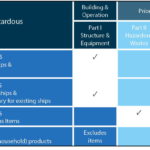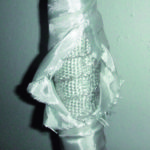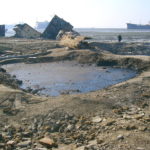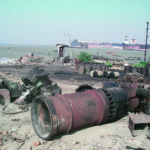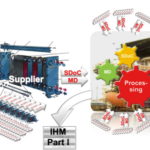International conventions call for a more holistic approach to shipbuilding and recycling. Common recycling is a soon-extinct business while hazardous materials remain an economic threat.
The attention paid to environmental aspects of shipping has increased steadily over many years now. Topics are stretching from oil[ds_preview] to garbage via waste and ballast water management plus the now hotter issue of gaseous emissions. Many shipowners show good practice and leadership by complying earlier than they have to. This can become a competitive advantage, as the cargo owners start to consider performance of their transport chains. However, what’s developing in the shadow of this is an even wider topic affecting and providing challenges for the whole maritime industry, from cradle to grave.
When thinking about where ships including all their equipment and some residues end up, quickly the pictures are getting fuzzy and some might get sandy beaches and barefoot workers in mind. This is still applicable for a number of ship breakers, but things have also changed here. Still, within the shipping industry though, not much consideration is given to the whereabouts of end of life ships, to their impacts and to the responsibilities of the maritime industry itself. All this is touched by the Hong Kong International Convention for the Safe and Environmentally Sound Recycling of Ships of IMO, known as »Hong Kong Convention«. Main focus of this convention on one side is the documentation of hazardous materials onboard ships throughout their lifetime and on the other side the standards and requirements for ship recycling facilities. The Hong Kong Convention is the first convention of IMO with a cradle to grave approach and the only one, which is solely regulating ship recycling.
Cradle to grave: supply chains and shipbuilders play a vital role
It’s common in other industries for years that manufacturers design dismantling and recycling-friendly products, to document all molecules in their products and to meet recycling quotas for materials. If those are not met, the legal requirements become tougher. It’s not that bad for the maritime industry, but the challenges ahead are often identical to those encountered by others – identification of hazardous materials in products on board ships and offshore structures above 500 GT.
Inventory of Hazardous Materials
Hazardous Materials contained in maritime structures, according to Hong Kong Convention, are to be documented in a so called Inventory of Hazardous Materials (IHM). Altogether three different parts of IHM have been defined by IMO:
• Part I: hazardous materials (HazMats) in structure and equipment of ships which have to be prepared and maintained during the life-time of a ship.
Required only before a ship is delivered to a recycling facility are:
• Part II: hazardous wastes on board, and
• Part III: HazMats in stores.
As shown in the box below, different tables containing different HazMats are related to these parts and a small relief is provided by Table D, excluding household-like appliances from the scope of IHM Part I. Without this exclusion, the various HazMats contained in refrigerators and normal electronic products used on board would have to be listed as well, making an IHM a book-like document which could hardly be maintained.
Jungle of requirements and certificates
Classification societies are offering IHM certificates already, unfortunately applying different standards. Some call the IHM still Green Passport, without any question a better term even though it’s questionable what green means when just listing hazardous materials. Unfortunately most of the Green Passports do not fulfill the new requirements of IMO, even though these have changed little within the last four years and the majority of today’s certifiers have attended the IMO meetings. Consequently, many certified Green Passports still prepared and certified today can’t even be used as source of information during IHM-preparations due to lack of compatibility. Even though a little might be used, it remains questionable how and by whom the Green Passport has been prepared. In case of missing background information, many guesstimates or assumptions, such a Green Passport including its certificate should end in the bin under your desk, including its certificate. It may be lucrative business for the certifiers, but makes the shipowners pay four times, for a second preparation of a hazardous materials list, this time an IHM, plus its certification.
The good thing is competition, as IHM-certification is open to class. Identification of those offering an up to date and thorough service is quite simple, they follow exactly todays IMO requirements, especially the IHM Guidelines (Res. MEPC 179(59) plus the yet to be published amendments of MEPC.62 in July 2011) and approve the VSCP before a HazMat Expert goes on board. Even though this requirement was deleted from an earlier draft IHM-Guideline, it was proposed for good reasons and is kept alive by those classes being serious about their responsibilities. In contrast to that, comprehensive liability disclaimers on certificates are a clear sign that these certifiers don’t trust their own work, but accept the business. So far only two classification societies have been found by us to be in compliance with the Hong Kong Convention, others follow the outdated Green Passport or have created their homebrew mix of GP and IHM. One of those societies claims that they have certified more than 900 Green Passports. The question remains, is this good news?
The cradle: New liabilities for suppliers and manufacturers
Under Hong Kong Convention, suppliers of shipyards and shipowners are obliged to provide »Material Declarations« (MDs). Any MD is to be covered by a »Suppliers Declaration of Conformity« (SDoC), a legally binding statement, that the information provided in MDs is accurate. The hazardous materials to be documented are provided in the so called Table A and Table B of Hong Kong Convention.
For some of them threshold levels exist, based on the basic law of chemistry – »the dose makes the poison«. All of the other listed HazMats without related threshold levels have to be listed when present. Provision of MDs is mandatory, even when no HazMats are to be reported.
Suppliers have to overtake liability for the information provided to their customers and risks can only be reduced, when their own supply chain is involved in the information gathering process. In case of main engine manufacturers easily a few thousand sub-suppliers are addressed, which deliver more or less complex parts. Clearly, involving sub-suppliers goes beyond the straight requirements of the Hong Kong Convention, as it addresses only the direct suppliers of shipyards and shipowners (Tier 1 suppliers). From a liability standpoint the question is who wants to distribute information which can bring him to court when not knowing all details? Liability lies with the first writer and a declaration is automatically understood to cover the full delivery or product. Appropriate documentation and archiving becomes essential when risks shall be kept on a manageable level.
Complex components should be accompanied by various MDs, based on the functional units. Otherwise maintenance and modifications will become more difficult. Additionally to that a modular setup for the data compiled is useful, for staying flexible and being able to react on customer specifications deviating from the standard product. Otherwise the effort for providing updated MDs is unnecessarily high. The demand for MDs and SDoCs is rising, not only from shipyards, but also from the rising number of shipowners, who have to maintain their newly prepared IHMs. Everybody knows that meeting the customers demand is essential in a highly competitive market.
The shipyards’ role under the Hong Kong Convention
The building yards have to collect the thousands of MDs and SDoCs from their suppliers for all components and materials used. The masses of hazardous materials according to Hong Kong Convention used have to be identified and combined with the locations onboard, basically that’s how an IHM-Part I is prepared. What sounds quite simple becomes a major task, seeing the complexity and huge number of materials and components needed plus the collection and control of incoming documents. The content of MDs from suppliers does not have to be checked, but tracking the requests and provision of information is a challenge on its own. The liability risks are as those of the suppliers. Nevertheless random checks could be advantageous, as nearly all ships are ordered with an asbestos-free certificate and in case asbestos is identified onboard the question of »duly made« comes up.
Today the major problem exists in lack of preparedness of suppliers. Only few are able to provide the required forms yet. Different certifiers provide different formats. Some of them are not even meeting the future IMO requirements and thus are only creating additional efforts and costs. However, when lack of MDs has to be compensated for delivering a ship in time, until entry into force of HKC alternative methods like own investigations can be used for filling the gaps.
It seems that many shipowners prefer to get IHMs prepared for their ships under construction. This potentially avoids hassles during ship operations caused by externals crawling around onboard for taking of samples. However, anybody having had those »HazMat Experts« on board can state that it is not a big issue, as long as they know what they’re doing.
Huge efforts required of shipowners and offshore industry
A unique element of the Hong Kong Convention is, that it addresses existing products as well, here existing ships and offshore platforms above 500 GT. The scope of the IHM is less wide than for new ships, but Table A materials, namely asbestos, PCBs, ozone depleting substances and TBT, are mandatorily to be investigated. Owners are responsible for getting the IHM prepared and have to nominate a designated person for IHM maintenance.
For IHM preparation they should seek support from HazMat Experts which overtake the complex task of sighting documents, preparation of a ship specific sampling plan – the Visual Sampling and Check Plan (VSCP) – taking of samples, contracting accredited laboratories and interpretation of the results plus mass calculations. Those steps end up in an IHM and as this is only a small essence of all their work, a good HazMat Expert provides also a more detailed report about the work conducted and further background information. Knowing absence of HazMats can be as important as like knowing about the identified hazardous items. It’s obvious, that this is not a task for crew members. Detailed knowledge and experience is a key for correct, timely, and effective IHM preparation. Anything else may result in misleading information and that is far more risky when used for planning of onboard maintenance, ship repairs or recycling than not having any IHM.
The IHM-maintenance will be required for as long as a ship exists. Setting up an effective communication system and procedures will make appropriate use of resources and becomes one of the tiny issues assuring a good overall performance and competitiveness.
Increased operational risks today
Currently in the Netherlands and Australia Port State Control investigates together with specialists, whether or not asbestos is present on board incoming ships. The PSC does not focus on older vessels, where potentially more asbestos may be present, but on ships falling under SOLAS Reg. II-1/3-5 (international ban of most installations of asbestos onboard ships delivered after June 2002, and complete ban since January 2011).
These inspections repeatedly have led to detentions, or bans of ships from territorial waters in Australia and the Netherlands when asbestos was detected. Consequently shipowners are facing risks of unpredictable port stays, fines, and even losing charter contracts, as the »fit for purpose requirement« is not met anymore. On top of this, nearly all ships are delivered with an »asbestos free certificate«, which is legally relevant but most often issued without appropriate investigations or control by the shipyards. Also it has been proven, that more than 90 % of all ships contain asbestos, no matter when and where they’ve been built. However, trying to get compensation from e. g. Chinese industry which builds most of the ships and has a huge supply industry, is nearly impossible from outside of China and thus the costs for decontamination and loss of income remains with the owners.
It seems to be difficult for maritime suppliers from China and some other countries to recognize the complete ban of asbestos, as they’re producing legal materials according to Chinese legislation. These materials are often found with imprints »non-asbestos« or »asbestos free«. The reason for this misunderstanding seems to be, that in China five out of six types of asbestos have been banned since 2009, but unfortunately not Chrysotile, which is one of the most often used types and can make up to 60 % of a material. Thus these materials are still containing asbestos, are in compliance with national legislation and are frequently traded internationally. This creates a problem in countries where all types of asbestos have been banned and SOLAS is enforced.
The still continuing use of asbestos has again been recognized by MSC of IMO in 2010 and its removal is required within three years of its detection (MSC.1/Circ. 1374). A more technical oriented approach rather than a purely legal one would be advantageous for the industry, as asbestos fibers themselves do not necessarily pose a risk, it’s their friability and how they’re managed. Thus not the presence of asbestos is important. Merely the associated risks should be in the focus. Based on risk categorizations further handling should be decided in contrast to the requirements of IMO and in line with the Corporate Social Responsibility.
The above leads to a loss of reputation of suppliers and shipbuilders like those from China when not tackling this problem sufficiently in a timely manner. It is important to raise awareness for avoiding problems, compensation claims by shipowners and ensure safe working conditions as well as legal compliance, not only with future IMO requirements like the Hong Kong Convention, but with todays SOLAS Convention.
Regional initiatives increase pressure to act now
The European Commission is working towards ship recycling legislation for all European countries including their ports and ships, probably and most hopefully in line with the Hong Kong Convention, as its entry into force is too far away for the many concerned. Good news is that an exception of ships from the non-practicable Basel Convention is aimed for, but the price to be paid for this is that it becomes much sooner. This probably will address all ships visiting European ports, approximately 30,000, requiring a certified IMH. Hopefully this includes a scheme for individual deadlines, as the number of ships cannot be handled within a few months or years with the available number of HazMat Experts and certification staff.
Globally 50,000 ships will fall directly or indirectly under the Hong Kong Convention, which includes the 30,000 ships visiting European ports. Additionally ship recycling facilities and offshore structures have to become compliant. It is unlikely that all flag states will ratify, but due to the »no more favorable treatment clause« each port of a ratifying state has to ensure that all incoming ships comply by having a certified IHM onboard, regardless of the flag they’re flying. The question is, when will which requirement be enforced and where do the required resources come from. A typical bottleneck is foreseeable, not preparing in time can be a missed chance of showing good practice and risking timely compliance during the peak season. For sure, the prices for IHM preparation and certification won’t be negotiable during the peak season.
The grave – the best for the rest?
Most ship recyclers from various countries claim that they’re almost compliant with the Hong Kong Convention. The question is how the distance between current practice and compliance is understood or measured. Besides the future common practice to prepare a ship specific Ship Recycling Plan (SRP), they first have to become authorized by their so called competent authority. For this a comprehensive Ship Recycling Facility Plan (SRFP) has to be prepared, containing amongst others the following information:
• Safety & Environmental protection
• Working methods
• Training & supervision
• Emergency preparedness
• Contractors, e.g. for disposal of wastes
Quite a few ship recyclers face a lot of work for improving towards safe and environmentally sound practices. Here ISO 30000 for ship recycling facility management is a solution, if applied properly. It provides good guidance and is in line with the requirements of Hong Kong Convention, it is even going further as it can expand to hinterland infrastructure due to not facing the same legal boundaries like IMO. Unfortunately, as like Green Passports, most ISO 30000 certificates do not reflect compliance. Especially appropriate waste treatment and disposal is lacking in Bangladesh and Pakistan and is partly limited in India and China. However, only the latter is generally accepted as being a green recycling country, besides Turkey, which unfortunately has a limited capacity. Generally an individual approach is needed for appropriately judging the abilities of facilities, as in countries the standards vary from one facility to the other. So far more than 40 ISO 30000 certificates have been issued, surprisingly none in China or Turkey and often by questionable certifiers. Thus todays ISO 30000 certificates can’t be used as indicator for good ship recyclers. Probably a result of recyclers preferences, looking for the cheapest and quickest certifier and not quality or looking for the benefits of a proper management system and experienced auditor.
Beaching or not – political discussions lack understanding
What is often used as an indicator for safe and sound recycling is the recycling method itself. Unfortunately only the most visible aspects are considered for this, which is how access to the ship is arranged. One of the reasons for focusing on banning beaching is the ease to transmit the message by photos. With this method pressure groups can easily maintain their campaigns and raise funds, but it’s not supporting improvements or changing the general difficulties the attacked countries are facing. Beaching is conducted in the generally less developed countries, where safety and environment are not as important as for example providing food for the people. These countries most often also lack proper waste management compared to more industrialized countries, which is a general problem, but mixing this with technical aspects of ship recycling is not only misleading, it’s unfair and counterproductive for further developments and investments.
Known are the following methods:
• Beaching, performed in Bangladesh,
Pakistan, and India
• Landing, applied in Turkey
• Alongside, used in China
• Dry-docking, like in the UK.
Interestingly the first three recycling methods above do all take place directly in or above water with only landing and alongside being accepted as appropriate. The disadvantage of keeping an eye on ships’ stability when applying the alongside method has not been considered so far, as like the capacity of oil booms in case a hull cracks which has not been properly cleaned. The picture shows less visible and more technical factors to be considered. The organization and coordination plus training of workers together make the difference. This can hardly be presented on posters, of course.
What is often lacking is increasing the effectiveness of recycling methods applied. The ships themselves provide a wide variety of materials and equipment, which could be used and modified for the ship recycling works, e.g. safe removal of asbestos or later sorting of materials for reaching higher purity and gaining higher prices of previously mixed materials. Removal works and waste management are generally to be seen as integrated business and additional options for service providers. If intelligently applied, it’s not a cost factor but an additional source of income.
Conclusions: Proactively turning risks into good practice
Raising awareness and identification of customers’ needs accompanied by an effective data management for gathering and maintaining information are the keys for suppliers and shipyards. Distribution of related requirements from clients to suppliers is the best way for raising awareness and triggering documentation in line with HKC.
Shipowners have to face the fact that they’re already in urgent need for a change. More than 90 % of ships of every age contain asbestos. The »operational risks« are huge and besides carefully choosing suppliers and shipbuilders, Port State Control in the Netherlands and Australia pose a permanent risk independently of entry into force of the Hong Kong Convention. Additionally, the European Commission plans own legislation for the end of 2011 in line with, but probably a bit more stringent than the Hong Kong Convention. Others might follow. Identification of potential risks and categorization thereof for taking technically appropriate measures like remediation safe operational procedures (SOP) is to be decided on an individual basis.
The only way to getting started is to get a quality-IHM prepared where identification of asbestos is a major issue. Considering if and how asbestos or other HazMats can be safely handled onboard is the second step. Approaching shipbuilders and manufacturers when they’ve provided or installed banned materials could be an option, too. This might turn costs for IHMs into compensation claims, but the question of safety and environmental protection should always be in focus. In fact IHM is the key for handling todays’ challenges and preparing for future compliance, as also reflected in the transitional measures as promoted by ICS and IMO.
Ship Recyclers should identify where they really are and what requirements their customers and future legislation have. Gaps are common and filling those should be done in an elaborate manner and over a period of time. Basically, the question has to be answered today, whether or not they want to remain in this business, as the common recycling is a soon-extinct business, except for some servants of niche markets. Competitive green ship recycling is the aim, and probably not as far away as many think.
In the end early preparation for compliance is showing good and responsible practice, a requirement of ISO 9001 and 14001 schemes.
Author:
Henning Gramann, Director,
GSR Services, Lüneburg
Phone +49 (0)4131 7898-194
henning.gramann@gsr-services.com
Henning Gramann






